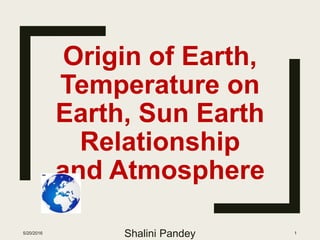
Res525 origin of earth and earth atmosphere
- 1. Origin of Earth, Temperature on Earth, Sun Earth Relationship and Atmosphere 5/20/2016 Shalini Pandey 1
- 2. ORIGIN OF EARTH ■ Earth, along with the other planets, is believed to have been born 4.5 billion years ago as a solidified cloud of dust and gases left over from the creation of the Sun. ■ For perhaps 500 million years, the interior of Earth stayed solid and relatively cool, perhaps 2,000°F. ■ The main ingredients were iron and silicates, with small amounts of other elements, some of them radioactive. ■ As millions of years passed, energy released by radioactive decay—mostly of uranium, thorium, and potassium—gradually heated Earth, melting some of its constituents.5/20/2016 Shalini Pandey 2
- 3. ORIGIN OF EARTH ■ After many years, the iron reached the centre, almost 4,000 miles deep, and began to accumulate. the turmoil that taken place on the face of Earth—bubbling on the surface, exploding volcanoes, and flowing lava covering everything insight. ■ Finally, the iron in the centre accumulated as the core. Around it, a thin but fairly stable crust of solid rock formed as Earth cooled. ■ Depressions in the crust were natural basins in which water, rising from the interior of the planet through volcanoes and fissures, collected to form the oceans. Slowly, Earth acquired its present appearance. 5/20/2016 Shalini Pandey 3
- 4. TEMPERATURE ON EARTH■ Planet Earth can support life. The planet is not too close or too far away from the sun. It lies in a "Goldilocks zone" that is just right — not too hot, not too cold. ■ The distance from Earth to the sun is one of the most important factors in making Earth habitable. ■ The average temperature on Earth is about 61 degrees F (16 C). But temperatures vary greatly around the world depending on the time of year, ocean and wind currents and weather conditions. ■ Summers tend to be warmer and winters colder. Also, temperatures tend to be higher near the equator and lower near the poles. 5/20/2016 Shalini Pandey 4
- 5. SUN EARTH RELATIONSHIP■ Figure 1 below shows that the orbit of the Earth about the sun is not circular. The path is elongated or elliptical. This means that the distance from the Earth to the sun varies through the year. Two special events are depicted in the diagram. Aphelion (July 4) is when the Earth is as far away from the sun as it ever gets. Perihelion (Jan. 3) is when the Earth is as close to the sun as it ever gets. 5/20/2016 Shalini Pandey 5
- 6. 5/20/2016 Shalini Pandey 6 ■ Sun is the main source of energy. ■ The spinning of the Earth about its axis is called Rotation. ■ One rotation takes about 24 hours or 1 day. ■ It rotate from west to east. ■ It revolve around a sun and takes 365 days s hours and 48 minutes. ■ Earth is 23 degree 30 minute tilted on its axis and thus make 66 degree 30 minute angle.
- 7. ATMOSPHERE ■ The atmosphere of is the layer of gases that surrounds the planet Earth and is retained by Earth's gravity. ■ The atmosphere protects life on Earth by absorbing ultraviolet solar radiation, warming the surface through heat retention and reducing temperature extremes between day and night. 5/20/2016 Shalini Pandey 7
- 8. Composition of atmosphere 5/20/2016 Shalini Pandey 8 ■ Nitrogen - 78.09% ■ Oxygen - 20.95% ■ Argon - 0.93% ■ carbon dioxide - 0.039% ■ small amounts of other gases ■ water vapor - 2%
- 9. Layers of Atmosphere ■ Troposphere ■ Stratosphere ■ Mesosphere ■ Thermosphere ■ Ionosphere ■ Exosphere 5/20/2016 Shalini Pandey 9
- 10. Troposphere ■ The lowest region in the Earth's atmosphere ■ Goes from ground (or water) level up to about 11 miles (17 kilo meters) high ■ The densest part of the atmosphere ■ All weather and clouds occur ■ Temperature generally decreases as altitude increases 5/20/2016 Shalini Pandey 10
- 11. Stratosphere ■ Starts just above the troposphere and extends to 50 kilo meters high ■ characterized by a slight temperature increase with altitude and the absence of clouds. ■ The ozone layer, which absorbs and scatters the solar ultraviolet radiation, is in this layer. ■ Provides ideal flying condition for large jet plane. 5/20/2016 Shalini Pandey 11
- 12. Mesosphere ■ The mesosphere starts just above the stratosphere and extends to 85 kilo meters high. ■ Meteors burn up in this layer. ■ The mesosphere is characterized by temperatures that quickly decrease as height increases. 5/20/2016 Shalini Pandey 12
- 13. Thermosphere ■ The thermosphere starts just above the mesosphere and extends to 600 kilo meters high. ■ Aurora and satellites occur in this layer. 5/20/2016 Shalini Pandey 13
- 14. Ionosphere ■ an abundant layer of electrons and ionized atoms and molecules that stretches from about 48 kilo meters above the surface to the edge of space at about 965 km, overlapping into the mesosphere and thermosphere. ■ This dynamic region grows and shrinks based on solar conditions and divides further into the sub-regions: D, E and F; based on what wavelength of solar radiation is absorbed. ■ The ionosphere is a critical link in the chain of Sun-Earth interactions. This region is what makes radio communications possible. Auroras occur in the ionosphere. 5/20/2016 Shalini Pandey 14
- 15. Exosphere ■ the outermost layer of the Earth's atmosphere. ■ The exosphere goes from about 640 km high to about 1,280 km. ■ The lower boundary of the exosphere is called the critical level of escape, where atmospheric pressure is very low (the gas atoms are very widely spaced) and the temperature is very low. 5/20/2016 Shalini Pandey 15
- 16. 5/20/2016 Shalini Pandey 16
- 17. 5/20/2016 Shalini Pandey 17
